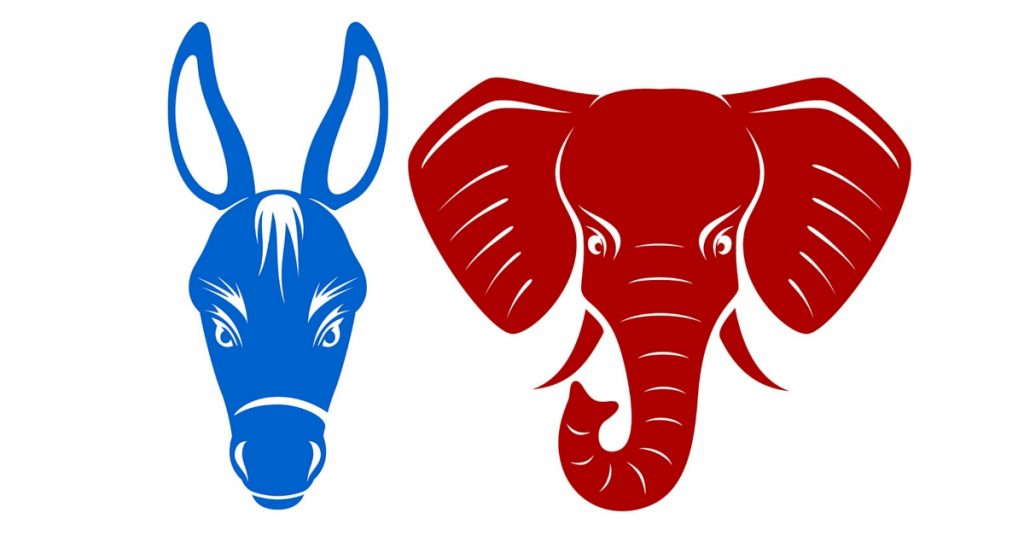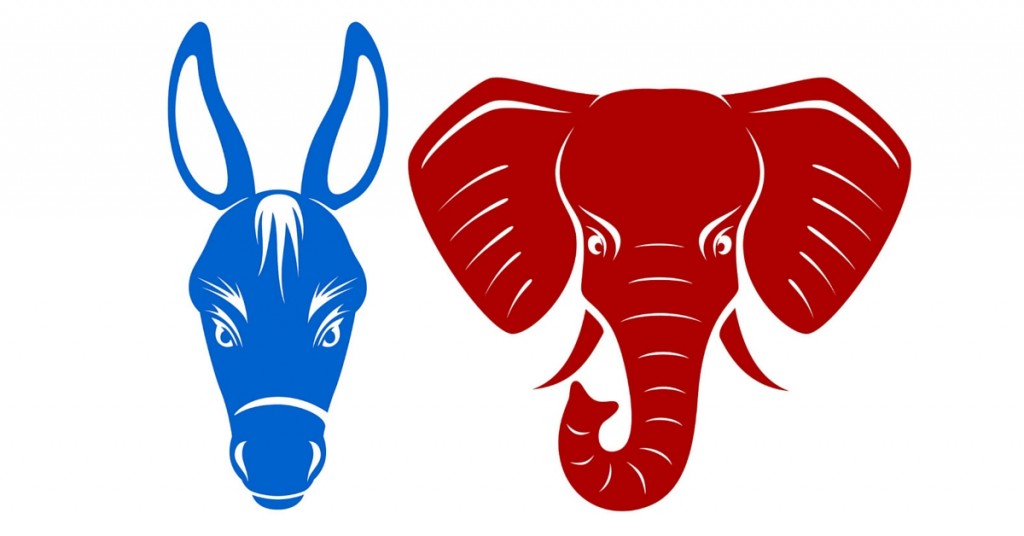American politics is—for better or for worse—entrenched in a two-party system. But the Founding Fathers never even intended for there to be political parties. Here’s the first part of the story of how we got the Dems and the Repubs. This article was first published in Uncle John’s Political Briefs.
Party Poopers
For all the diversity of opinion among the Founding Fathers in the 1770s, there was one thing that virtually everyone agreed upon: political parties were a very bad idea.
In his farewell address as president, George Washington referred to political parties as “the worst enemy” of democratic governments, “potent engines by which cunning, ambitious, and unprincipled men will subvert the power of the people.” Alexander Hamilton equated political parties with “ambition, avarice, and personal animosity.” And Thomas Jefferson could hardly agree more: “If I could go to heaven but with a party,” he wrote, “I would not go there at all.”
English Lessons
The Founding Fathers’ abhorrence of political parties was in response to the partisan politics that characterized England’s House of Commons. The Commons was supposed to serve as a check on the power of the monarch, but successive kings had been able to use their vast wealth, power, and control of public offices to create a party of royalists. Thus, it had been reduced to members fighting among themselves instead of working together to advance the common good.
This was what the Founding Fathers were trying to avoid in the United States: warring factions that would pursue selfish interests at the expense of the nation.
But what exactly was the national interest? And if the Founding Fathers couldn’t agree on what the national interest was, who among them got to decide? These fundamental questions caused the first factions to form in American political life.
First Feud: The Articles of Confederation
Bringing the original 13 colonies together to form the United States had not been easy. The Founding Fathers drafted the first U.S. Constitution, the Articles of Confederation, in 1777, but it was flawed. The Americans had just won independence from one central government—England—and they were reluctant to surrender the power of the individual states to a new central government, so they intentionally made that government weak.
But it soon became obvious that the federal government established by the Articles of Confederation was too weak to be effective at all. The most glaring problem was that it had no power to tax the states, which meant that it had no means of raising money to pay for an army to protect its territories from encroachment by Britain and Spain. In 1787 a constitutional convention was held in Philadelphia to draw up an entirely new document.
It was during the debates over the creation and ratification of the new constitution that some of the first and most significant political divisions in American history began to emerge. Those who supported the idea of strengthening the federal government by weakening the states were known as “Federalists,” and those who opposed the new constitution became known as the “Anti-Federalists.”
The Federalists won the first round: 9 of the 13 states ratified the U.S. Constitution, and Congress set March 4, 1789, as the date it would go into effect. Elections for Congress and the presidency were held in late 1788. George Washington ran unopposed and was elected president.
Trouble in the Cabinet
Washington saw the presidency as an office aloof from partisan divisions and hoped his administration would govern the same way. But by 1792, Washington’s cabinet had split into factions over the financial policies of Alexander Hamilton, the secretary of the treasury.
Perhaps because he was born in the British West Indies and thus did not identify strongly with the interests of any particular state, Hamilton was the foremost Federalist of his age. He strongly believed in using the power of the federal government to develop the American economy. In 1790 he proposed having the government assume the remaining unpaid Revolutionary War debts of the states and the Continental Congress. This would help establish the creditworthiness of the new nation, albeit by enriching the speculators who bought up the war debt when most people thought it would never be repaid. Hamilton’s plan also meant that states that had already paid off their war debt would now be asked to help pay off the debts of states that hadn’t, which added to the controversy.
Secretary of State Thomas Jefferson supported the new Constitution but had Anti-Federalist leanings. He grudgingly agreed to support Hamilton’s plan, on one condition: Hamilton had to support Jefferson’s plan to locate the new capital city on the banks of the Potomac River. Hamilton agreed.
Hamilton got his debt plan, and in return Jefferson got Washington, D.C. (Jefferson later regretted the deal, calling it one of the greatest mistakes of his life.)
A Battle Royal
Then in December 1790, Hamilton proposed having Congress charter a Bank of the United States as a means to regulate U.S. currency. This time Jefferson thought Hamilton had gone too far. He vehemently opposed the idea, arguing that a national bank would benefit the commercial North more than the agricultural South (Jefferson was a Southerner), and would further enrich the wealthy while doing little to help common people.
Hamilton’s financial policies, Jefferson said, were intended to create “an influence of his [Treasury] department over the members of the legislature,” creating a “corrupt squadron” of congressmen and senators who would work “to get rid of the limitations imposed by the Constitution [and] prepare the way for a change, from the present republican form of government, to that of a monarchy, of which the English constitution is to be a model.”
Like Jefferson, Hamilton deplored political parties. But he and his supporters were also adamant about chartering a national bank and strengthening the powers of the federal government. Faced with the determined opposition of Jefferson and his allies, they began to organize what became known as the Federalist Party. The young nation had its first political party, but another one was right on its heels.













